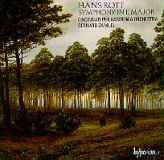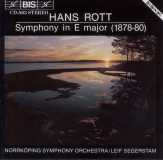Updated
on
January 4, 2025 |
 |
 |
 |
 |
 |
 |
 |
 |
 |
|
|
 |
 |
 |
 |
 |
 |
 |
| |
 |
|
| Hyperion, typically intrepid in its repertoire choices,
brought out the symphony's first commercial recording
in 1984 (originally CDA 66366, currently at midprice as Helios
CDH 55140). Gerhard Samuel expounds the score a bit cautiously,
but he has a good feeling for the character of the various
episodes.
He inflects the cantabile themes sensitively, and grounds
even the more vigorous passages in a flowing lyricism, making
the sprawling structures sound logical. Only the carefully
monitored final coda, where the blazing sonority doesn't open
out triumphantly as it should, disappoints. (Wasn't digital
technology supposed to eliminate these volume restrictions?)
The
Cincinnati Philharmonia, a student ensemble based at that city's
College-Conservatory of Music, plays with more attractive
tone and better ensemble than some nominally professional orchestras
in the former Eastern bloc. Their weaknesses lie in the occasional
ensemble insecurity (in the opening theme, for example, the
horn and flutes don't quite move together) and somewhat underpowered
strings
(in the tuttis, only the high treble register of the violin
themes allows them to project clearly over the brass). If other
conductors have since projected this musical edifice with greater
assurance and individuality, Samuel's non-intervention policy
allows us to hear the composer's personality as if unmediated,
making his intelligent, sensitive, and well-engineered performance
a good overall introduction to the piece. |

Cincinnati Philharmonia
Orchestra
Gerhard Samuel
|
| Altogether more daring is Leif Segerstam, who, in his 1992
account (Bis CD-563), takes the risks that Samuel avoids, using
flexible tempi to limn a heartfelt, expressive performance
that,
deliberately or not, emphasizes the reminiscences and foreshadowings
of better-known composers. There is Mahler, of course: in the
aching, wistful horn solo in the Trio (track 3, 5:04)
and the Finale's ominous, Resurrection-like
one (track 4, 2:36). Perhaps not unexpectedly, Segerstam
also makes us hear Sibelius in the opening's cool, stoic grandeur
and the
hushed, prayerful Sehr langsam chorale (though similar
breadth stretches the one at the movement's close almost to
the breaking point). Smetana's Blaník flashes by in
the first movement's "toy march," Dvorak's Eighth in the woodwinds'
dark Picardy third at 3:55 of the Finale. Throughout
the piece, the conductor brings out the brass in the Russian
manner - without the wobbles, fortunately! - thus producing
uncommonly brilliant sonorities. The trumpets are a bold,
brazen
presence in the first-movement development; the horn entry
in the Sehr langsam chorale, ordinarily treated as filler,
is prominently
underlined; the brass themes cut proudly through the Finale's
vaulting second fugue. But, where such fussing over detail
renders Segerstam's Mahler unduly episodic, the results here
are more cohesive. The outer-movement climaxes build steadily
and organically; the Finale's
main theme, with the strings more sustained than usual, is
uplifting
and positive. The conductor is judicious in deploying Rott's
constantly ringing triangle, and he sorts out the noisy final
perorations into a truly musical culmination. The Norrköping
Symphony responds to Segerstam with enthusiasm and a lustrous
sheen. The Bis engineers abet the trumpets' tendency to excessive
brightness, but otherwise reaffirm the company's audiophile
reputation. |

Norrköping Symphony
Orchestra
Leif Segerstam
|
| Part 5 |
|
back to Part 3
|
|